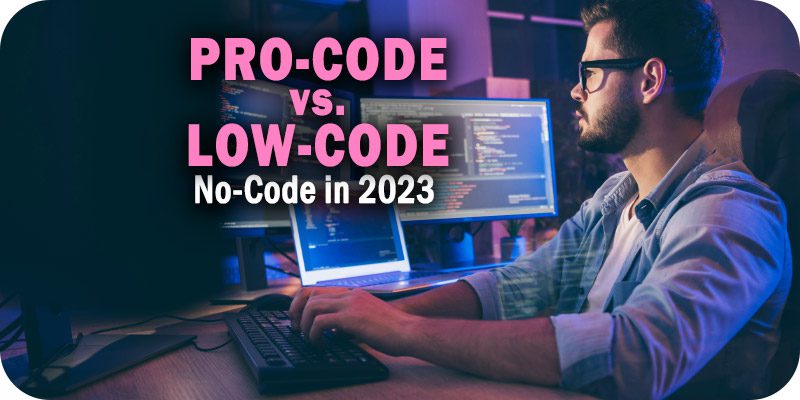Pro-Code vs. Low-Code/No-Code in 2023


As part of Solutions Review’s Premium Content Series—a collection of contributed columns written by industry experts in maturing software categories—Shiva Nathan, the Founder & CEO of Onymos, outlines what the pro-code versus no-code/low-code conversation might look like in 2023.
 Coding is not easy. If you are a software company, that presents a problem. This year, Codesubmit reported, “Around 40 million technical jobs go unfulfilled due to a lack of skilled talent.” It is no wonder tech leaders are looking for a different solution—one without code. For example, low-code and no-code platforms—like OutSystems, Mendix, and Bubble—are growing in popularity and making converts from non-technical founders and software engineers. Gartner predicts that low-code/no-code will help power 50 percent of all apps built by medium-to-large enterprises in 2023.
Coding is not easy. If you are a software company, that presents a problem. This year, Codesubmit reported, “Around 40 million technical jobs go unfulfilled due to a lack of skilled talent.” It is no wonder tech leaders are looking for a different solution—one without code. For example, low-code and no-code platforms—like OutSystems, Mendix, and Bubble—are growing in popularity and making converts from non-technical founders and software engineers. Gartner predicts that low-code/no-code will help power 50 percent of all apps built by medium-to-large enterprises in 2023.
So, in 2023, should your organization stop being pro-code (using “traditional” programming languages, tools, and technology)? Should app creators stop arguing over different software and enroll in an online boot camp instead? Should you ask your recruiters to give a little more consideration to applicants with Weebly or Wix experience on their resumes instead of CSS or JavaScript?
Probably not.
Does Low-Code/No-Code Live Up to the Hype
To understand that better, you first must understand what low-code/no-code is. Many think of “low-code/no-code” as interchangeable with “drag-and-drop development.” Using drag-and-drop development platforms, app creators can access dozens (sometimes even hundreds) of prefab UI widgets, features, and integrations. All these are abstracted from the complexities of frameworks, functions, and SDKs that proponents of low-code/no-code argue for gatekeeping application development. That is why if you hear someone talking about democratizing app dev, they are probably talking about low-code/no-code.
But low-code/no-code is not synonymous with drag-and-drop app builders. Think of Mailchimp and automating email marketing, or Zapier and event triggers. These are popular examples of low-code/no-code too. These platforms are compatible with traditional, pro-code app development but not its replacement. This might not be what comes to mind when most people think about the “low-code/no-code revolution,” but it is what analysts are referring to when they talk about the low-code/no-code that 50 percent of apps will use next year.
Very often, there really is no “versus” in “pro-code vs low-code/no-code.” Most of the time, pro-code (like GitHub Copilot) and low-code/no-code (like Airtable) technologies are just complementary tools for developer enablement. What about when it is a choice between using HTML, CSS, and JavaScript and using Appian, Retool, or Webflow? Do low-code/no-code drag-and-drop app builders live up to the hype? Vendor lock-ins and scalability are always concerns, but some startups have undeniably leveraged these platforms and their lower barriers to entry very well.
The More Things Change, the More They Stay the Same
Tara Reed, the non-technical founder of the fine arts company Kollecto, was one of Bubble’s early success stories. In a guest blog post she wrote for Bubble in 2015, Tara said, “I came across Bubble on Product Hunt and was immediately interested and was able to build a new app in just a few weeks. I was also lucky to stumble upon AirDev, an agency that builds apps for people using Bubble, and they helped me construct my art-matching algorithm.”
Tara continues to advocate for low-code/no-code through her online school, Apps Without Code. But, noticeably, hiring an app development agency to build your (low-code/no-code) app is not all that different from hiring an app development agency to build your (pro-code) app. For example, Matt Varughese, CEO of a no-code app development agency, said, “More and more people are looking to build their ideas but won’t necessarily want to spend the time learning the ins-and-outs of no-code to make it happen, which is where no-code freelancers and agencies come into play to assist. Since no-code enables all of us to move faster without code, we can, in turn, move faster than traditional dev shops.”
This all sounds very similar to what a traditional app development agency might say to “people looking to build their ideas.” Just replace “no-code” with “JavaScript,” and the reason they can move faster with “our tech stack.” So, yes, coding is not easy, but the reality is that not coding is not easy either. Skillfully doing either requires deep knowledge of software architecture, data governance, and much more. That is why AirDev and 8020 are successful.
In 2023, Choose Developer Enablement
In 2023, tech leaders should recognize when “pro-code versus no-code” or “pro-code versus low-code” is a false dichotomy. Often, it will be. When it is not, know that your app creators’ skill and expertise are the most crucial factor. Enabling them will always be the surest way to succeed, no matter what year it is.



















